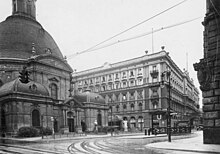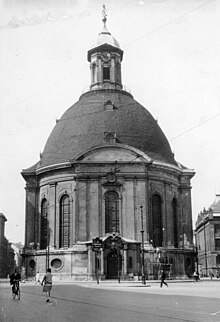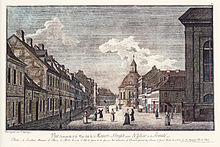Trinity Church (Berlin)
The Dreifaltigkeitskirche was a Protestant church in Friedrichstadt . Today this part of Friedrichstadt belongs to the Berlin district Mitte in the district of the same name and to the church district Berlin Stadtmitte .
Location and surroundings

The church was located on a triangular area at the junction of Mauerstrasse and Kanonierstrasse (since 1951 Glinkastrasse ) on the southern side of Mohrenstrasse in the immediate vicinity of Zietenplatz and the Hotel Kaiserhof, which was destroyed in the war . Part of the property of the destroyed Trinity Church is now part of the North Korean embassy . To the east in front of it, on Glinkastraße, the plan of the former church building is indicated by colored stones in the pavement. Three parsonages used as residential and community centers were built in the Glinkastraße / Taubenstraße area and some of them are still preserved today (Glinkastraße 16 and Taubenstraße 3). A similar church building, the Bohemian Bethlehem Church , consecrated in 1737 , was located in the immediate vicinity (today Bethlehemkirchplatz ).
Building history
The city expansion initiated by King Friedrich Wilhelm I also made new church buildings necessary. In August 1737 the foundation stone was laid for the Trinity Church planned by the newly appointed Oberland master builder Titus de Favre . The building, erected with the participation of the court mason Christian August Naumann , was consecrated on August 30, 1739. The Dreifaltigkeitskirche was the last Protestant church to be built in Berlin for about a hundred years. A baptistery and a vestibule with a sacristy extension were built between 1885 and 1886 according to plans by the architects Carl Vohl and Friedrich Schulze . During the Second World War, the interior of the Trinity Church burned down in an air raid in November 1943. The ruins, which had been converted into an air raid shelter for the NSDAP headquarters, were destroyed by street fighting shortly before the end of the war, except for the surrounding walls, and in 1947 it was blown up .
Exterior design
The Dreifaltigkeitskirche was a round building with four short projections that suggested a cross shape. The baroque sacred building had a domed roof over a central building 22 meters in diameter. The tiled wooden dome had an octagonal lantern that served as a bell tower.
Interior design

The church hall was initially surrounded by three galleries. On the east side, the altar, pulpit and organ were arranged one above the other. The wooden dome was decorated with images of the evangelists Mark, Matthew, Luke and John. The top gallery was removed during a renovation by the builder Adolf Lohse in 1864.
Others
The first pastor of the Trinity Church was by order of King Friedrich Wilhelm I, the pedagogue and theologian Julius Hecker . The church building was temporarily used as barracks in 1806 during the occupation of Berlin by Napoleon . The theologian Friedrich Schleiermacher preached in the Dreifaltigkeitskirche from 1809 to 1834. At Easter 1831 he confirmed the later Chancellor Otto von Bismarck . Ernst Dryander was a pastor from 1882 to 1898. Paul von Hindenburg used the church for Sunday prayer. Dietrich Bonhoeffer preached in his time as a private lecturer and student chaplain at the Technical University of Berlin from 1932–1933 in the academic services of the Trinity Church. After the Second World War, church services were held in the community center at Wilhelmstrasse 115 at least until the end of the 1970s.
The church included the Dreifaltigkeitskirchhof I and Dreifaltigkeitskirchhof II cemeteries , both in Kreuzberg, and Dreifaltigkeitskirchhof III in Berlin-Mariendorf. Another, not preserved, cemetery of the Trinity Community was in front of the Potsdamer Tor .
As already happened in 1999 at Bethlehemkirchplatz, the site and part of the floor plan of the church in the form of a paving mosaic directly in front of the entrance to the embassy of North Korea were made visible again as part of the renovation work on Mauerstrasse and Glinkastrasse in 2008 .
literature
- Rudolf Herz: Berlin Baroque. Buildings and builders from the first half of the 18th century . German Publishing Society for Politics and History MBH, Berlin 1928.
- W. Boeck, H. Richartz: Old Berlin churches . Atlantis-Verlag, Berlin 1937, p. 82.
- Günther Kühne, Elisabeth Stephani: Evangelical churches in Berlin . Christlicher Zeitschriftenverlag, Berlin 1978, ISBN 3-7674-0158-4 , p. 377.
- Götz Eckardt (ed.): Fates of German architectural monuments in the Second World War. A documentation of the damage and total losses in the area of the German Democratic Republic. Vol. 1. Berlin - capital of the GDR, districts Rostock, Schwerin, Neubrandenburg, Potsdam, Frankfurt / Oder, Cottbus, Magdeburg , Henschel Verlag, Berlin 1980, p. 5 (with illustrations and references).
Web links
- Information about and photos of the Trinity Church
- Search for Dreifaltigkeitskirche (Berlin) in the German Digital Library
- Search for Dreifaltigkeitskirche Berlin in the SPK digital portal of the Prussian Cultural Heritage Foundation
Individual evidence
Coordinates: 52 ° 30 '42.8 " N , 13 ° 23' 10.9" E

